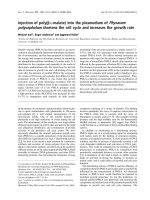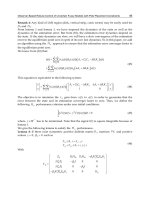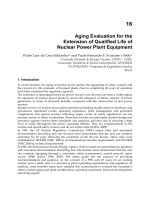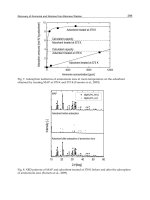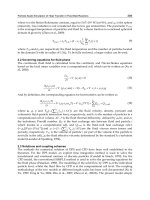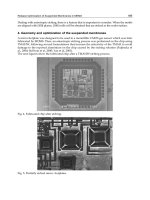Cell Metabolism Cell Homeostasis and Stress Response Part 11 pot
Bạn đang xem bản rút gọn của tài liệu. Xem và tải ngay bản đầy đủ của tài liệu tại đây (260.52 KB, 15 trang )
Intracellular Metabolism of Uranium and the Effects of Bisphosphonates on Its Toxicity
141
Haley, D. (1982). Morphologic changes in uranyl nitrate-induced acute renal failure in
saline- and water-drinking rats. Lab Invest., Vol. 46(2), pp. (196-208).
Harris BW et al. Experimental clearance of urannium dust from the body. In: Darries CN,
Editors, (1961) Inhaled Particles and Vapuors. Pergamon
Harrison, J., & Stather, J. (1981). The gastrointestinal absorption of protactinium, uranium,
and neptunium in the hamster. Radiat Res. Vol. 88(1), pp. (47-55).
Henge-Napoli, M., Archimbaud, M., Ansoborlo, E., Metivier, H., & Gourmelon, P. (1995).
Efficacy of 3,4,3-LIHOPO for reducing the retention of uranium in rat after acute
administration. International Journal of Radiaiont Biology, Vol. 68, pp. (389-393)
Henge-Napoli, M., Ansoborlo, E., Chazel, V., Houpert, P., Paquet, F., & Gourmelon, P.
(1999). Efficacy of ethane-1-hydroxy-1,1 bisphosphonate (EHBP) for the
decorporation of uranium after intramuscular contamination in rats. International
Journal of Radiation Biology, vol.75, pp. (1473-1477).
Hoffman, D., Heinz, G, Sileo, L., Audet, D., Campbell, J., LeCaptain, L., & Obrecht, H.
(2000). J. Toxicol. Environ. Health A., Vol. 59, pp. (235–252).
Hunaiti, A., & Soud, M. (2000). Effect of lead concentration on the level of glutathione,
glutathione S-transferase, reductase and peroxidase in human blood. Sci. Total
Environ., Vol. 248, pp. (45–50).
Hursh, J., Neuman, W., Toribara, T., Wilson, H., & Waterhouse C. Oral ingestion of uranium
by man. (1969). Health Phys. Vol. 17(4), pp. (619-21).
Hursch, J., & Spoor, N. (1973). Data on man. In: Hodge HC, Stannard JN, Hursh JS, eds.
Uranium, Plutonium Transplutonic elements. Handbook of Experimental
Pharmacology, vol 36: 197-239. Berlin-Heidelberg: Springer-Verlag, 1973
ICRP. 1995. Age-dependent doses to members of the public from intake of radionuclides:
Part 3, Ingestion dose coefficients. ICRP Publication 69. Oxford: Pergamon Press.
International Commission for Radiation Protection.
ICRP. 1996. Age-dependent doses to members of the public from intake of radionuclides:
Part 4, Inhalation dose coefficients. ICRP Publication 71. Oxford: Pergamon Press.
International Commission for Radiation Protection.
Inoue, K., Takano, H., Yanagisawa, R., Sakurai, M., Ichinose, T., Sadakane, K., & Yoshikawa,
T. (2005). Effects of nano particles on antigen-related airway inflammation in mice.
Respir. Res., Vol. 6, pp. ( 106–117).
Kalinich, J., Ramakrishnan, N., Villa, V., & McClain, D. (2002). Depleted uranium-uranyl
chloride induces apoptosis in mouse macrophages. Toxicology, Vol. 179, pp. (105–
114).
Kern, M., & Audesirk, G. (2000). Stimulatory and inhibitory effects of inorganic lead on
calcineurin. Toxicology, Vol. 150, pp. (171-178).
Kirsch-Volders, M., Vanhauwaert, A., Eichenlaub-Ritter, U., & Decordier, I. (2003). Indirect
mechanisms of genotoxicity. Toxicol. Lett. Vol. 63, pp. (140–141).
Kong, X., Liao, L., Lei, D, Huang, J., & Wen XD. (2000). Influence of lead on activity of nitric
oxide synthase in neurons and vessel smooth muscle of small intestine in rats.
Hunan Yi Ke Da Xue Xue Bao, Vol. 25(2), pp. (135-7).
Cell Metabolism – Cell Homeostasis and Stress Response
142
Korashy, H., & El-Kadi, A. (2006). Transcriptional regulation of theNAD(P)H:quinone
oxidoreductase 1 and glutathione S-transferase genes by mercury, lead, and
copper. Drug Metab Dispos., Vol. 34(1), pp. (152-65).
Kreyling, W., Semmler, M. & Möller, W. (2004). Dosimetry and toxicology of ultrafine
particles. J Aerosol Med., Vol. 17, pp. ( 140-152).
Kurttio, P., Auvinen, A., Salonen, L., Saha, H., Pekkanen, J., Mäkeläinen, I., Väisänen, S.,
Penttilä, I., & Komulainen, H. (2002). Renal effects of uranium in drinking water.
Environ Health Perspect., Vol. 110(4), pp. (337-342).
La Touche, Y., Willis, D., & Dawydiak O. (1987). Absorption and biokinetics of U in rats
following an oral administration of uranyl nitrate solution. Health Phys., Vol. 53(2),
pp. (147-162).
Leach, L., Maynard, E., Hodge, H., Scott, J., Yuile, C., Sylvester, G., & Wilson, H. (1970). A
five-year inhalation study with natural uranium dioxide (UO 2) dust. I. Retention
and biologic effect in the monkey, dog and rat. Health Phys., Vol. 18, pp. (599-
612).
Leach, L., Gelein, R., Panner, B., et al. (1984). The acute toxicity of the hydrolysis products of
uranium hexafluoride (UF6) when inhaled by the rat and guinea pig. Final report.
ISS K/SUB-81-9039-3. DE84011539.
Leggett, R., & Harrison, J. (1995). Fractional absorption of ingested uranium in humans.
Health Phys., Vol. 68(4), pp. (484-498).
Lestaevel, P., Romero, E., Dhieux, B., Ben Soussan, H., Berradi, H., Dublineau, I., Voisin, P.,
& Gourmelon, P. (2009). Different pattern of brain pro-/anti-oxidant activity
between depleted and enriched uranium in chronically exposed rats. Toxicology,
Vol. 258(1), pp. (1-9).
Lin, R., Wu, L., Lee, C., & Lin-Shiau, S. (1993). Cytogenetic toxicity of uranyl nitrate in
Chinese hamster ovary cells. Mutat Res. Vol. 319(3), pp. (197-203).
Linares, V., Belles, M., Albina, M., Sirvent, J., Sanchez, D., & Domingo, J. (2006). Assessment
of the pro-oxidant activity of uranium in kidney and testis of rats. Toxicol. Lett., Vol.
167, pp. (152-161).
Lohmann-Matthes, M., Steinmüller, C., & Franke-Ullmann G. (1994). Pulmonary
macrophages. Eur Respir J. Vol. 7(9), pp. (1678-89). Review.
López, R., Díaz Sylvester, P., Ubios, A., & Cabrini, R. (2000). Percutaneous toxicity of uranyl
nitrate: its effect in terms of exposure area and time. Health Phys., Vol. 78(4) pp.
(434-7).
Lu, S., & Zhao, F. (1990). Nephrotoxic limit and annual limit on intake for natural U. Health
Phys., Vol. 58(5) pp. (619-623).
MacNee, W., Li, X., Gilmour, P., & Donaldson, K (2000). Systemic effect of particulate air
pollution. Inhal Toxicol., Vol. 12 (3), pp.( 233-244).
Macnider, W. (1916). The inhibition of the toxicity of uranium nitrate by sodium carbonate,
and the protection of the kidney acutely nephropathic from uranium from the toxic
action of an anesthetic by sodium carbonate. J Exp Med 1, Vol. 23(2), pp. (171-87).
Mao, Y., Desmeules, M., Schaubel, D., Bérubé, D., Dyck, R., Brûlé, D., & Thomas, B. (1995).
Inorganic components of drinking water and microalbuminuria. Environ Res
., Vol.
71(2), pp. (135-140).
Intracellular Metabolism of Uranium and the Effects of Bisphosphonates on Its Toxicity
143
Martin, L., Krunkosky, T., Dye, J., Fischer, B., Jiang, N., Rochelle, L., Akley, N., Dreher, K., &
Adler, K. (1997). The role of reactive oxygen and nitrogen species in the response
of airway epithelium to particulates. Environ. Health Perspect. Vol. 105(5), pp.
(1301–1307).
Martinez, A., Cabrini, R., & Ubios, A. (2000). Orally administered ethane-1-hydroxy-1,1-
bisphosphonate reduces the lethal effect of oral uranium poisoning. Health Physics.,
Vol. 78, pp. (668-671).
Martínez, A., Mandalunis, P., Bozal, C., Cabrini, R., & Ubios, A. (2003). Renal function in
mice poisoned with oral uranium and treated with ethane-1-hydroxy-1,1-
bisphosphonate (EHBP). Health Phys., Vol. 85, pp. (343-347).
McDiarmid, M., Keogh, J., Hooper, F., McPhaul, K., Squibb, K., Kane, R., DiPino, R., Kabat,
M., Kaup, B., Anderson, L., Hoover, D., Brown, L., Hamilton, M., Jacobson-Kram,
D., Burrows, B., & Walsh, M. (2000). Health effects of depleted uranium on exposed
Gulf War veterans. Environ Res., Vol. 82(2), pp. (168-180).
McDiarmid, M., Hooper, F., Squibb, K., McPhaul, K., Engelhardt, S. M., Dipino, R., & Kabat,
M. (2002). Health effects and biological monitoring results of Gulf War veterans
exposed to depleted uranium. Mil. Med., Vol. 167, pp. (123–124).
McDiarmid, M., Engelhardt, S., Oliver, M., Gucer, P., Wilson, P., Kane, R., Kabat, M., Kaup,
B., Anderson, L., Hoover, D., Brown, L., Handwerger, B., Albertini, R., Jacobson-
Kram, D., Thorne, C., & Squibb, K. (2004). Health effects of depleted uranium on
exposed Gulf War veterans: A 10-year follow-up. J Toxicol Environ Health A., Vol.
67(4), pp. (277-296).
McDiarmid, M., Engelhardt, S., Oliver, M., Gucer, P., Wilson, P., Kane, R., Cernich, A.,
Kaup, B., Anderson, L., Hoover, D., Brown, L., Albertini, R., Gudi, R., Jacobson-
Kram, D., & Squibb, K., ( 2007). Health surveillance of Gulf War I veterans exposed
to depleted uranium: Updating the cohort. Health Phys., Vol. 93(1), pp. (60-73).
McDiarmid, M., Engelhardt, S., Dorsey, C., Oliver, M., Gucer, P., Wilson, P., Kane, R.,
Cernich, A., Kaup, B., Anderson, L., Hoover, D., Brown, L., Albertini, R., Gudi, R.,
& Squibb, K. (2009). Surveillance results of depleted uranium- exposed Gulf War I
veterans: Sixteen years of follow-up. J Toxicol Environ Health A., Vol. 72(1), pp. (14-
29).
McNeilly, J., Jimenez, L., Clay, M., MacNee, W., Howe, A., Heal, M., Beverland, I., &
Donaldson, K. (2005). Soluble transition metals in welding fumes cause
inflammation via activation of NF-jB and AP-1. Toxicol. Lett., Vol. 158, pp. (152–
157).
Miller, A., Stewart, M., Brooks, K., Shi, L., & Page, N. (2002) Depleted uranium-catalyzed
oxidative DNA damage: absence of significant alpha particle decay. J Inorg
Biochem., Vol. 91(1), pp. (246-52).
Miller, A., Brooks, K., Stewart, M., Anderson, B., Shi, L., McClain, D., & Page, N. (2003).
Genomic instability in human osteoblast cells after exposure to depleted uranium:
Delayed lethality and micronuclei formation. J. Environ. Radioact., Vol. 64, pp. (247–
259).
Cell Metabolism – Cell Homeostasis and Stress Response
144
Miller, A., Stewart, M., & Rivas, R. (2010). Preconceptional paternal exposure to depleted
uranium: transmission of genetic damage to offspring. Health Phys., Vol. 99(3), pp.
(371-9).
Monleau, M., Bussy, C., Lestaevel, P., Houpert, P., Paquet, F., & Chazel, V. (2005).
Bioaccumulation and behavioural effects of depleted uranium in rats exposed to
repeated inhalations. Neuroscience Letters, Vol. 390, pp. (31-6).
Monleau, M., De Meo, M., Frelon, S., Paquet, F., Donnadieu-Claraz, M., Duménil, G., &
Chazel, V. (2006). Distribution and genotoxic effects after successive exposure to
different uranium oxide particles inhaled by rats. Inhal Toxicol., Vol. 18(11), pp.
(885-894).
Muller, C., Ruzicka, L., & Bakstein, J. (1967). The sex ratio in the offspring of uranium miners
Acta Univ. Carolinae Med., Vol. 13, pp. (599–603).
Neuman, M., & Neuman, W. (1948). The deposition of uranium in bone; radioautographic
studies. J Biol Chem., Vol. 175(2), pp. (711-4).
Oberdörster, G., Ferin, J., & Lehnert BE. (1994). Correlation between particle size, in vivo
particle persistence, and lung injury. Environ Health Perspect., Vol. 102, pp. (173-
179).
Oberdörster, G., Sharp, Z., Atudorei, V., Elder, A., Gelein, R., Lunts, A., Kreyling, W., & Cox,
C. (2002) Extrapulmonary translocation of ultrafine carbon particles following
whole-body inhalation exposure of rats. J Toxicol Environ Health, Vol. 65A, pp.
(1531-1543).
Orcutt, J. (1949). The toxicology of compounds of uranium following application to the skin.
In: Voegtlin C, Hodge HC, eds. Pharmacology and toxicology of uranium
compounds. Vols 3 and 4. New York, NY: McGraw Hill Book Co., 377-414.
Orona, N. (2009). Tesis de Licenciatura en Biotecnología: Citotoxicidad del nitrato de uranilo
sobre células del sistema fagocítico mononuclear. Universidad Nacional de San
Martín-IIB.
Orona, N., & Tasat, D. DU (uranyl nitrate) - exposed rat alveolar macrophages encounter
cell death through different intracellular signaling pathways. (umpublished).
Ortega, A., Domingo, J., Gomez, M., & Corbella, J. (1989). Treatment of experimental acute
uranium poisoning by chelating agents. Pharmacology and Toxicology, Vol. 64, pp.
(247-251).
Osburn, W., & Kensler, T. (2008). Nrf2 signaling: an adaptive response pathway for
protection against environmental toxic insults. Mutat Res., Vol. 659(1-2), pp. (31-
9).
Patrick, L. (2006). Lead toxicity part II: the role of free radical damage and the use of
antioxidants in the pathology and treatment of lead toxicity. Altern. Med. Rev. Vol.
11, pp. (114–127).
Pavlakis, N., Pollock, C., McLean, G., & Bartrop, R. (1996). Deliberate overdose of uranium:
Toxicity and treatment. Nephron., Vol. 72, pp. (313–317).
Peccorini, V., Ubios, A., Marzorati, M., & Cabrini, R (1990). Toxicidad del uranio. Estudio
experimental de los productos del Complejo Minero Fabril de San Rafael
(Mendoza), Gerencia de Investigaciones (CNEA).
Intracellular Metabolism of Uranium and the Effects of Bisphosphonates on Its Toxicity
145
Pellmar, T., Keyser, D., Emery, C., Hogan, J. (1999). Electrophysiological changes in
hippocampal slices isolated from rats embedded with depleted uranium fragments.
Neurotoxicology, Vol. 20(5), pp. (785-792).
Periyakaruppan, A., Kumar, F., Sarkar, S., Sharma, C., & Ramesh, G. (2007) Uranium
induces oxidative stress in lung epithelial cells. Archives of Toxicology, Vol. 81(6),
pp. (389-395).
Periyakaruppan, A., Sarkar, S., Ravichandran, P., Sadanandan, B., Sharma, C., Ramesh, V.,
Hall, J., Thomas, R., Wilson, B., & Ramesh, G. (2009). Uranium induces apoptosis in
lung epithelial cells. Arch Toxicol., Vol. J83(6), pp. (595-600).
Petitot, F., Frelon, S., Moreels, A., Claraz, M., Delissen. O., Tourlonias. E., Dhieux. B.,
Maubert.,C., & Paquet, F. (2007a). Incorporation and distribution of uranium in rats
after a contamination on intact or wounded skin. Health Phys., Vol. 92(5), pp. (464-
474).
Petitot, F., Gautier, C., Moreels, A., Frelon, S., & Paquet, F. (2007b). Percutaneous
penetration of uranium in rats after a contamination on intact or wounded skin.
Radiat Prot Dosimetry. Vol. 127(1-4), (125-130).
Pinney, S., Freyberg, R., Levine, G., Brannen, D., Mark, L., Nasuta, J., Tebbe, C., Buckholz, J.,
& Wones, R. (2003). Health effects in community residents near a uranium plant at
Fernald, Ohio, USA. Int. Occup. Med. Environ. Health, Vol. 16, pp. (139–153).
Prat, O., Berenguer, F., Malard, V., Tavan, E., Sage, N., Steinmetz, G., & Quemeneur, E.
(2005). Transcriptomic and proteomic responses of human renal HEK293 cells to
uranium toxicity. Proteomics, Vol. 5(1), pp. (297-306).
Prat, O., Bérenguer, F., Steinmetz, G., Ruat, S., Sage, N., & Quéméneur, E. (2010).
Alterations in gene expression in cultured human cells after acute exposure to
uranium salt: Involvement of a mineralization regulator. Toxicol In Vitro, Vol.
24(1), pp. (160-8).
Pujadas Bigi, M., Lemlich, L., Mandalunis, P., & Ubios, A. (2003). Exposure to oral uranyl
nitrate delays tooth eruption and development. Health Phys., Vol. 84(2), (163-9).
Pujadas Bigi, M., & Ubios, A. (2007). Catch-up of delayed tooth eruption associated with
uranium intoxication. Health Phys., Vol. 92(4), pp. (345-348).
Research Triangle Institute “Uranium: Draft for public comment”, September 1997.
Saccomano, G., Auerbach, O., Kushner, M., Harley, N., Michels, R., Anderson, M., (1996)
Bechtel, J. A comparison between the localization of lung tumors in uranium
miners and non miners from 1947 to 1991. Cancer, Vol. 77(7), pp. (1278-1283).
Schins, R. & Borm, P. (1999). Mechanisms and mediators in coal dust induced toxicity: a
review. The Annals of Occupational Hygiene, Vol. ( 43), pp.( 7–33).
Schnelzer, M., Hammer, G., Kreuzer, M., Tschense, A., Grosche, B. (2010). Accounting for
smoking in the radon-related lung cancer risk among German uranium miners:
results of a nested case-control study. Health Phys. Vol. 98(1), pp. (20-8).
Simmons, M., & Murphy, S. (1993). Cytokines regulate L-arginine-dependent cyclic GMP
production in rat glial cells. Eur J Neurosci., Vol. 5(7), pp. (825-31).
Simons, T. (1993). Lead-calcium interactions in cellular lead toxicity. Neurotoxicology, Vol.
14, pp. (77-85).
Cell Metabolism – Cell Homeostasis and Stress Response
146
Smith, D., & Black, S.(1975). Actinide concentrations in tissues from cattle grazing near the
Rocky Flats Plant. Report: ISS NERC-LV-529-536.
Stearns, D., Yazzie, M., Bradley, A., Coryell V., Shelley, J., Ashby, A., Asplund, C., & Lantz,
R. (2005). Uranyl acetate induces hprt mutations and uranium–DNA adducts in
Chinese hamster ovary EM9 cells. Mutagenesis, Vol. 20(6), pp. (417-423).
Stoeger, T., Reinhard, C., Takenaka, S., Schroeppel, A., Karg, E., Ritter, B., Heyder, J., &
Schulz, H. (2006). Instillation of six different ultrafine carbon particles indicates a
surface area threshold dose for acute lung inflammation in mice. Environ Health
Perspect., Vol. 114(3), pp. (328-33).
Stohs, S. & Bagchi D. (1995). Oxidative mechanisms in the toxicity of metal ions. Free Radic
Biol Med , Vol. 18(2): pp. (321-36).
Stokinger, H., Baxter, R., Dygert, H., et al. 1953. Toxicity following inhalation for 1 and 2
years. In: Voegtlin C, Hodge HC, eds. Pharmacology and toxicology of uranium
compounds. New York, NY: McGraw-Hill, 1370-1776.
Stradling, G., Gray, S., Moody, J., & Ellender, M. (1991). Efficacy of tiron for enhancing the
excretion of uranium from the rat. Hum Exp Toxicol., Vol. 10(3), pp. (195-8).
Tannenbaum, A., Silverstone, H., & Koziol, J. (1951). Tracer studies of the distribution and
excretion of uranium in mice, rats, and dogs. In: Tannenbaum A, ed. Toxicology of
uranium compounds. New York, NY: McGraw-Hill, 128-181.
Tasat, D., & De Rey, B. (1987). Citotoxic effect of uranium dioxide on rat alveolar
macrophages. Environmental Research., Vol. 44, pp. (71-81).
Tasat, D., Orona, N., Mandalunis, P., Cabrini, R., & Ubios, A. (2007). Ultrastructural and
metabolic changes in osteoblasts exposed to uranyl nitrate. Arch Toxicol., Vol. 81(5),
pp. (319-26).
Thiébault, C., Carrière, M., Milgram, S., Simon, A., Avoscan, L., & Gouget, B. (2007).
Uranium induces apoptosis and is genotoxic to normal rat kidney (NRK-52E)
proximal cells. Toxicol Sci., Vol. 98(2), pp. (479-87).
Thompson, J., & Nechay, B. (1981). Inhibition by metals of a canine renal calcium,
magnesium-activated adenosinetriphosphatase. J Toxicol Environ Health., Vol. 7(6),
pp. (901-8).
Tirmarche, M., Baysson, H., & Telle-Lamberton, M. (2004). Uranium exposure and cancer
risk: a review of epidemiological studies. Rev Epidemiol Sante Publique., Vol. 52(1),
pp. (81-90).
Tissandie, E., Guéguen, Y., Lobaccaro, J., Paquet, F., Aigueperse, J., & Souidi M. (2006).
Effects of depleted uranium after short-term exposure on vitamin D metabolism in
rat. Arch Toxicol., Vol. 80(8), pp (473-80).
Tissandié, E., Guéguen, Y., Lobaccaro, J., Grandcolas, L., Voisin, P., Aigueperse, J.,
Gourmelon, P., & Souidi, M. (2007). In vivo effects of chronic contamination with
depleted uranium on vitamin D3 metabolism in rat. Biochim Biophys Acta., Vol.
1770(2), pp. (266-72).
Ubios, A., Guglielmotti, M., Steimetz, T., & Cabrini, R. (1991). Uranium inhibits bone
formation in physiologic alveolar bone modeling and remodeling. Environ. Res.,
Vol. 54, pp. (17-23).
Intracellular Metabolism of Uranium and the Effects of Bisphosphonates on Its Toxicity
147
Ubios, A., Braun, E., & Cabrini R. (1994). Lethality due to uranium poisoning is prevented
by ethane-1-hydroxy-1,1-bisphosphonate (EHBP). Health Physics., Vol. 66, (540-
544).
Ubios AM, Piloni MJ, Marzorati M, Cabrini RL. (1995). Bone growth is impaired by uranium
intoxication. Acta Odontol Latinoamer, Vol 8, (3-8).
Ubios, A., Marzorati, M., & Cabrini, R. (1997). Skin alterations induced by long-term
exposure to uranium and their effect on permeability. Health Phys., Vol. 72(5), pp.
(713-715).
Ubios, A., Braun, E., & Cabrini R. (1998). Effect of bisphosphonates on abnormal
mandibular growth in rats intoxicated with uranium. Health Physics., Vol. 75, pp.
(610-613).
Uijt de Haag, P., Smetsers, R., Witlox, H., Kru¨s, H., & Eisenga, A.(2000). Evaluating the risk
from depleted uranium after the Boeing 747-258F crash in Amsterdam, 1992. J.
Hazard. Mater. Vol. A76, pp. 39–58.
UNSCEAR 1993 REPORT: SOURCES AND EFFECTS OF IONIZING RADIATION United
Nations Scientific Committee on the Effects of Atomic Radiation UNSCEAR 1993
Report to the General Assembly, with Scientific Annexes.
USTUR. 2011. United States transuranium and uranium registries radiochemical analysis
procedures manual. Pullman, WA: Washington State University, Nuclear Radiation
Center, Manual # 01
Vaziri, N., & Ding, Y. (2001). Effect of lead on nitric oxide synthase expression in coronary
endothelial cells: Role of superoxide. Hypertension, Vol. 37. pp. (223-226).
Voegtlin, C. & Hodge, H. (1949). Pharmacology and Toxicology of Uranium Compounds
(First Ed.). New YorkLondon: McGraw Hill.
Walinder, G., Hammarstrom, L., & Billandelle, U. (1967). Incorporation of uranium. I.
Distribution of intravenously and intraperitoneally injected uranium. Br J Indust
Med., Vol. 24, pp.( 305-312).
Wan, B., Fleming, J., Schultz, T., & Sayler, G. (2006). In vitro immune toxicity of depleted
uranium: effects on murine macrophages, CD4+ T cells, and gene expression
profiles. Environ Health Perspect., Vol. 114(1), pp. (85-91).
Williams, M., Tanner, J., & Hughes, P. (1974). Catch-up growth in male rats following
growth retardation during the suckling period. Pediatr Res. Vol. 8, pp. (149-156).
WISE Uranium Project. www.wiseproject.org (1999)
Wrenn, M., Durbin, P., & Howard, B. (1985). Metabolism of ingested uranium and radium.
Health Phys., Vol. 48, pp. (601-633).
Xie, H., LaCerte, C., Douglas Thompson, W., & Wise, J. (2010). Depleted uranium induces
neoplastic transformation in human lung epithelial cells. Chemical Research in
Toxicology, Vol. 23 (2), pp. (373-378).
Zamora, M., Tracy, B., Zielinski, J., Meyerhof, D., & Moss, M. (1998). Chronic ingestion of
uranium in drinking water: A study of kidney bioeffects in humans. Toxicol Sci.,
Vol. 43(1), pp. (68-77).
Zamora, M., Zielinski, J., Meyerhof, D., & Tracy B. (2002). Gastrointestinal absorption of
uranium in humans. Health Phys., Vol. 83(1), pp. (35-45).
Cell Metabolism – Cell Homeostasis and Stress Response
148
Zamora, M., Zielinski, J., Moodie, G., Falcomer, R., Hunt, W., & Capello, K. (2009). Uranium
in drinking water: Renal effects of long-term ingestion by an aboriginal
community. Arch Environ Occup Health, Vol. 64(4), pp. (228-241).
Zhu, Z., Yang, R., Dong, G., & Zhao ZY. (2005). Study on the neurotoxic effects of low-level
lead exposure in rats. J Zhejiang Univ Sci B., Vol 6(7), pp. (686-92).
7
Photodynamic Therapy to
Eradicate Tumor Cells
Ana Cláudia Pavarina
1
, Ana Paula Dias Ribeiro
1
,
Lívia Nordi Dovigo
1
, Cleverton Roberto de Andrade
2
,
Carlos Alberto de Souza Costa
2
and Carlos Eduardo Vergani
1
1
Araraquara Dental School, UNESP- Univ Estadual Paulista,
Department of Dental Materials and Prosthodontics
2
Araraquara Dental School, UNESP- Univ Estadual Paulista,
Department of Phisiology and Pathology
Brazil
1. Introduction
The cell cycle is a collection of highly ordered processes involving numerous regulatory
proteins that guide the cell through a specific sequence of events culminating in the
duplication of the cell (Elledge, 1996). In general, the cell cycle can be altered to the
advantage of many factors. Three basic cell cycle defects are mediated by misregulations of
cyclin-dependent kinases (CDKs), unscheduled proliferation, genomic instability (GIN) and
chromosomal instability (CIN). In the first case, mutations result in constitutive mitogenic
signaling and defective responses to anti-mitogenic signals. The second, GIN, leads to
additional mutations (Kastan & Bartek, 2004), and CIN is responsible for numerical changes
in chromosomes (Lee et al., 1999). Moreover, data suggest that the mutations leading to
tumorigenesis are even more numerous and heterogeneous than previously thought
(Hudson et al., 2010). This accumulation of genetic mutations can arise by nucleotide
substitutions, small insertions and deletions, chromosomal rearrangements and copy
number changes that can affect protein-coding or regulatory components of genes. Cancer
genomes usually acquire somatic epigenetic “marks” compared to non-neoplastic tissues
from same organ (Hudson et al., 2010). In this context, a neoplasm (Greek, neo = new + plasis
= growth) can be defined as an abnormal mass of tissue whose growth exceeds and is
uncoordinated with that of the normal tissue, and persists in the same excessive manner
after cessation of the stimuli that initiated the change.
Head and neck cancer is considered a worldwide problem due to its raising in developing
countries (Lim et al., 2011). Approximately 90% of this type of cancer consists of oral
squamous cell carcinoma (OSCC), which arises from the oral mucosal lining (Neville & Day,
2002). The risk factors related to OSCC includes tobacco and alcohol abuse, solar exposure,
human papillomavirus, immunosuppression conditions, iron deficiency anemia in
combination with dysphagia and esophageal webs, and tumor genesis that can occur as a
result of genetic predisposition or epigenetic pathway involving DNA and/or histone
modification (Neville & Day, 2002; Schweitzer & Somers, 2010). Although there have been
Cell Metabolism – Cell Homeostasis and Stress Response
150
many advances in the conventional treatment, the survival rate for patients with late stage
of OSCC is the lowest of the major cancers, remaining at 50% over the last two decades
(Neville & Day, 2002; Funk et al., 2002). The standard treatment for early OSCC includes
surgery, radiation, chemotherapy or a combination of these procedures. However, the side
effects of these treatments are severe and can result in structural defects leading to
dysphagia, and also hyperpigmentation, scars and xerostomia (Hooper et al., 2004;
Schweitzer & Somers, 2010). Therefore, alternative treatments have been proposed in order
to reduce the toxicity and side effects from the conventional therapies.
Less invasive surgical modalities including the Photodynamic Therapy (PDT) are examples
of new treatments that comprise the era of conservative surgery (Karakullukcu et al., 2011).
In this context, the purposes of this chapter are: 1. discuss about PDT as a relatively new
therapy for treating head and neck neoplasms including its advantages and disadvantages
when compared to conventional treatments; 2. describe the pathophysiology of cancer cells
that allows the photosensitizer to accumulate on these cells rather than normal tissue and
mechanisms of cell/tumor death; 3. review the in vivo findings avaiable in the literature; and
4. present the anti-tumor effect observed in vitro when Hela cells were exposed to
Curcumin, a natural photosensitizer.
2. Photodynamic therapy
PDT is a relative recent therapy, and excellent results have been reported after its
application for the treatment of oral cancer and premalignant lesions (Allison et al., 2005; Yu
et al., 2008), as well as bacterial and fungal infections (Teichert et al., 2002; Williams et al.,
2006; Donnelly et al., 2008). The simplicity of PDT mechanism stimulated the interest for this
therapy, which is characterized by the association of a photosensitizing agent (PS) and
visible light with a wavelength compatible with the photosensitizer’s absorption spectrum
(Konopka & Goslinski, 2007; Buytaert et al., 2007). Photon absorption by the PS leads it to a
triple state of excitation that may interact with the available oxygen, in two different ways.
The reaction type 1 involves electron/hydrogen transfer directly from the PS or
electron/hydrogen removal from a substrate molecule to form free radicals such as
superoxide, hydroxyl radicals, and hydrogen peroxide. The reaction type 2 involves the
production of the electronically excited and highly reactive state of oxygen known as singlet
oxygen (Konopka & Goslinski, 2007). Both reactions can occur at the same time and the PS’
characteristics and the substrate molecules are important components to define the ratio of
each reaction. All these products originated from PDT may result in a cascade of oxidative
events that cause direct cell death, destruction of tumor vascularization and activation of the
host’s immune response (Buytaert et al., 2007).
The success of PDT depends on several parameters such as the type and concentration of the
PS, its localization during the irradiation, the pre-incubation period with the drug, type of
light sources, light fluence and density, type of tumor and its level of oxygenation (Dolmas
et al., 2003). Regarding the PS, the most commonly used in PDT for cancer treatment
includes porphyrins, phthalocyanines, the 5-aminolevulinic acid and chlorine. These PSs
have been preferentially selected due to their approval for clinical use. In the present, PDT
has been approved for use in clinical treatment in the USA, EU, Canada, Russia and Japan
(Bredell et al., 2010). The Food and Drug Administration (FDA) has approved the treatment
of Barret’s esophagus, obstructing esophageal and tracheobronchial carcinomas with
Photodynamic Therapy to Eradicate Tumor Cells
151
Photofrin, a hematoporphyrin derivate. Moreover, it has also approved the treatment for
actinic keratosis with Levulan (aminolevulinic acid) and for macular degeneration with
Verteporfin (benzoporphyrin derivate monoacide). In the EU, the same conditions have
been approved adding the treatment for early head and neck cancer and palliative treatment
for this type of cancer with Foscan, a tetrahydroxy-phenyl chloride (mTHPC) (Biel, 2007).
This diversity of photosensitizers leads to differences in the PDT protocol, including
differences in the dose and pre-incubation period with the photosensitive drug.
The pre-incubation period is extremely important in the photosensitizer toxicity and its
intracellular localization. Hsieh et al. (2003) observed that when Photofrin remained in
contact with tumor cells for one hour, the PS was retained in the plasma membrane;
however, when this period was increased to 24 hours, the PS penetrated into the cells and
caused cell damage even in the absence of light (Hsieh et al., 2003). Triesscheijn et al. (2004)
found that a lower light dose was sufficient to reduce cell viability when a higher pre-
incubation time was used for several cell types. Moreover, the PS localization defines the
primary site of photodamage and also the type of cell death occurred after PDT. Generally,
the PSs that accumulate in mitochondria or endoplasmic reticulum cause apoptosis, while
those that accumulate in the plasma membrane or lysosomes predispose cells to necrosis
(Buytaert et al., 2007). Also, PDT can induce authophagy in attempt to repair the
photodamage and turn into a cell death signal if the initial response fails (Kessel & Oleinick,
2009). Usually the PSs do not accumulate in the nucleus, which results in a low mutagenic
and genotoxic potential of PDT. A study evaluating DNA damage after PDT observed that
the treatment with methylene blue associated with halogen light irradiation against a
keratinocytes culture did not cause any DNA damage after 4 hours, even with a 90%
percentage of cellular lysis (Zeina et al., 2003).
Light is an essential component of PDT reaction and it is able to interact and modify some
cellular responses. According to Brancaleon & Moseley (2002), the choice of an adequate
light source can be dictated by the location of the tumour, the light dose required and the
type of the PS used. PDT has been traditionally performed using lasers (Light Amplification
Stimulated Emission). Examples of this category of light are the argon, argon-pumped dye,
metal vapour-pumped dye, solid state, and diode lasers. However, the use of these large
and complex equipments can be limited due to the expensive technologies and maintenance
required. Because of such disadvantages, lasers are not the only light sources that have been
investigated for photodynamic purposes. Studies have reported the use of halogen light and
LED (Light Emitting Diode). The LED is a category of light source that emits radiation in a
wider range of the spectrum, but with a dominant wavelength. Moreover, the device has a
lower cost and simpler technology compared to laser.
The main advantage of PDT is the limited tissue damage restricted to the illuminated and
photosensitized area without long-term systemic side effects (Cooper et al., 2007;
Karakullukcu et al., 2011). It also does not cause damage to normal structures like nerves,
collagen fibers and large blood vessels, preserving the supporting components (Bredell et al.,
2010). This means that when cancer cells are eliminated via apoptosis/necrosis the
extracellular matrix remains forming a scaffold for the surrounding mucosal tissue to
advance over, resulting in minimal scar formation. Moreover, this therapy can be repeated
as often as needed without accumulative destructive effects and there is no interaction
between current chemo- and radiotherapy protocols and PDT. The most common
Cell Metabolism – Cell Homeostasis and Stress Response
152
disadvantages are the photosensitivity that can lead to burn wounds, pain that can vary
from mild to severe resolving within 2-3 weeks, and possible poor initial selectivity between
tumor and normal tissue (Biel, 2007; Bredell et al., 2010). Although PDT presents some local
side effects, it does not involve systemic or serious adverse events. Despite these advantages
compared to the conventional treatments, the lack of clinical knowledge and especially the
lack of established treatment protocols lead to the limited application of this treatment in the
head and neck cancer field.
3. Characteristics of tumor cells and mechanisms of tumor destruction by
PDT
The effectiveness of PDT treatment depends on the ability of the PS to selectively localize in
tumor cells as opposed to normal cells. The selectivity of PDT to tumor cell is a result of
some important characteristics of these cells such as greater proliferative rates, leaky
vasculature, poor lymphatic drainage, high expression of low-density lipoprotein (LDL)
receptors on tumor cells, to which the PS can bind, and low pH facilitating cellular uptake of
the PS.
The antitumor effects of PDT against tumor cells include the direct cytotoxic effect, damage
to the tumor vasculature, and induction of inflammatory reaction (systemic immunity)
(Agostinis et al., 2011). Three PDT death pathways are described: apoptosis, autophagy and
necrosis. The apoptosis mechanisms remain obscure and complex. Kessel & Luo (1998)
described that apoptosis occurred when PS was accumulated in the mitochondria, but not
when PS was located in the cytoplasmatic. Furre et al. (2006) showed that PDT can induce
apoptosis through both cytochrone c-mediated caspase-dependent and AIF-induced
caspase-dependent pathway. In addition, Baglo et al. (2011) described that PDT triggers a
complex cellular response involving several biological pathways, but apparently involve
both caspase dependent and independence apoptotic pathways. Specifically in head and
neck cancer, PDT seems to active caspase-8 and caspase-9 pathway and their upstream NF-
kB-JNK pathways (Chen et al., 2011). In summary, lysosomal membrane rupture and
leakage of cathepsins involve mitochondria outer membrane permeabilization (MOMP)
controlled by Bcl-2 family members. Autophagy is a complex cellular process involving
dynamic membrane rearrangements and degradation of cell components through the
lysosomal activity related to energy homeostasis, organelle turnover, and cancer death
(Stromhaug & Klionsky, 2001). Buytaert et al. (2007) identified autophagy as a mode of cell
death after PDT. While PDT treated murine embryonic fibroblasts WT (wild-type) and
DKO-mtBAX (DKO reexpressing mtBAX) cells exhibited cellular shrinkage and membrane
blebs characteristic of apoptotic cell death, the DKO (double-knockout, BAX and BAK) cells
and DKO-SERCA (DKO overexpressing SERCA2) cells readily showed extensive cytosolic
vacuolization which was remarkably prevented by class III phosphatidylinositol 3-kinase
(PI3K), necessary for the sequestration of cytoplasmic material on autophagy process
(Buytaert et al., 2007). The mechanisms and roles of autophagy following PDT could also
differ markedly in different cell types, depending on a variety of cell characteristics,
including their propensity to undergo apoptosis and in response to agents that produce
different types or locations of damage and its lead to more resistant (organelle turnover) or
death of cancer cells (Kessel & Oleinick, 2009). For necrosis, the PS is excited by light and
then reacts with oxygen to generate reactive oxygen species (ROS) that ultimately lead to
Photodynamic Therapy to Eradicate Tumor Cells
153
cell death. ROS can lead damage to proteins, nuclei acids and lipids, proteins change
functions with attack to disulfide bonds and thiol groups. Another effect of ROS could be
the modification of Ca
2+
channels (Vanlangenakker et al., 2008). The increase of permeability
of mitochondrial membrane is probably a dynamic process that can activate apoptosis or
succumb to necrosis (Gramaglia et al., 2004). Mitochondria controls cytoplasmic
concentration of Ca
2+
by tuning the frequency of cytosolic Ca
2+
waves, and this mechanism
is potentially lethal and would rapidly activate a variety of enzymes in an uncontrolled
fashion (Rasola & Bernardi, 2011). The fact that cancer cells can die through different
mechanisms is a relevant clue in the choice and design of anticancer PDT (Panzarini et al.,
2011).
The antivascular effects of PDT. Star et al. (1986) described direct evidence of endothelial
damage from the histological sections of blood vessels showing destruction of the vessel
wall. The effects observed were blanching (ischemia) of tumor, the circulation gradually
slows down, leading to complete stasis (hour to day after irradiation), vasodilatation and
hemorrhage (dose related) (Star et al., 1986). The directly cytotoxicity of endothelial cells
were described with sublethal doses of PDT. Gomer et al. (1988) showed that bovine
endothelial cells were significantly more sensitive than smooth muscle cells or fibroblast
from the same species and conclude that endothelial cell photosensitivity may play a role in
the vascular damage observed following PDT.
The inflammatory and immune response: The PDT oxidative stress and associated cell
damage explain the strong acute inflammatory reaction. Moreover, the acute inflammation
is characterized by increased expression of several pro-inflammatory cytokines including
TNF-a, IL-1b, and IL-6, adhesion molecules E-selectin and ICAM-1, and rapid accumulation
of leukocytes into the treated tumor bed (Brackett & Gollnick, 2011). It also involves the
maturation and activation of dendritic cells, and ability to stimulate T cell activation
(Brackett & Gollnick, 2011). Pre-clinical and clinical studies have demonstrated that PDT
eliminates tumors by direct tumor cell death and indirectly by augmenting anti-tumor
immunity. An in vitro study showed that PDT caused the suppression of several tumour-
promoting factors in head and neck cancer such as MMP-2, MMP-9, uPA and VEGF. The
study do not confirm whether PDT reduces the invasive potential of malignant head and
neck cells, but it presents the suppression of factors responsible for tumor invasion which
may be of therapeutic value (Sharwani et al., 2006).
4. In vivo findings for head and neck cancer treatmente with PDT
Several clinical studies have evaluated the potential of PDT for treating head and neck
cancer using approved photosensitizers (Cooper et al., 2007; Biel, 2007; Schweitzer &
Somers, 2010; Karakullukcu et al., 2011). In a study reported by Biel (2007), 276 patients with
early head and neck squamous carcinoma were treated with Photofrin, a first generation PS.
After 48 hours, the light exposition was performed with laser using different light fluencies
and densities depending on the localization of the tumor (oral cavity, larynx) under local
anesthesia. The cure rates with a single treatment for early laryngeal and oral cancers were
91% and 94%, respectively. A study using the same PS showed that PDT was able to provide
local control in 80% of cases with diffuse aggressive mucosal carcinoma in situ of the oral
cavity/oropharynx, especially in patients in which conventional treatment failed
(Schweitzer & Somers, 2010).
Cell Metabolism – Cell Homeostasis and Stress Response
154
The second generation of PSs was improved in order to give greater tumor selectivity and
allow deeper light penetration into the tissue as a result of its longer excitation wavelength
(Allison et al., 2004). Foscan, a clorin, was the only second-generation PS studied in clinical
trials (Biel, 2007). A recent study analyzed 170 patients with 226 lesions that included
primary (95) and non-primary (131) oral cavity and oropharynx neoplasms. It was observed
an overall response rate of 90.7% with a complete response rate of 70.8% (Karakullukcu et
al., 2011). This study also revealed the difference in response rates between different regions
in the oral cavity. For example the tongue reacts significantly better than alveolar process,
showing that some sub-sites present better characteristics for PDT as flat surface for a more
homogenous light deliver. Cooper et al. (2007) evaluated 27 patients with secondary or
multiple primary head and neck cancer treated with mTHPC intravenously. After 4 days,
the tumor area was irradiated with a 652 nm laser under general anesthesia. After 24 hours
from the treatment, necrosis and formation of slough at the tumor area was observed. In 28
of the 42 tumors, a complete remission was obtained which represents a complete response
of 67%. The authors observed a great difference between the cure rates for stage I/in situ
(85%) when compared to stage II/III (38%). These results emphasize the importance of an
early diagnosis and periodic follow-up in order to discover new primary tumors in a curable
stage.
The clinical studies using ALA mediated PDT showed that this drug has a limited depth
accumulation that results in limited penetration of light reducing the application of this
therapy. In the study of Fan et al. (1998), 18 patients that were diagnosed with dysplasia and
malignant lesions in the oral cavity were treated with ALA mediated PDT, and only two of
six patients with tumor obtained a complete response. Moreover, Sireon et al. (2001)
observed that only a partial response was obtained after treating patients diagnosed with
larynx carcinomas using ALA-PDT. Therefore, more studies with a greater number of
patients using correct including criteria should be done in order to evaluate the potential of
ALA-mediated PDT to treat head and neck cancer.
5. Evaluation of the antitumor potential of curcumin-mediated PDT
Recently, medicinal plants have become the focus of intense study regarding the
prevention and/or treatment of several chronic diseases. Turmeric, the powdered
rhizome of Curcuma longa L., has been used to treat a variety of inflammatory conditions
and chronic diseases (Ammon & Wahl, 1991). Curcumin (CUR) is a naturally occurring,
intensely yellow turmeric pigment that it is in worldwide use as a cooking spice, flavoring
agent and colorant
(Epstein et al., 2010). An increasing number of investigations have
suggested that CUR exhibits potential therapeutic applications such as anti-inflamatory,
antioxidant, antimicrobial, antifungal and anticancer properties (Epstein et al., 2010;
Martins et al., 2009). Some studies also showed that CUR inhibits chemically induced
carcinogenesis in the skin, forestomach, and colon when it is administered during
initiation and/or postinitiation stages (Kawamori et al., 1999; Huang et al.,1994). Some
studies have also propose that these effects may possibly be enhanced by combination
with light (Bruzell et al., 2005; Dujic, et al., 2009), thus attracting researches to explore its
use in several areas including photochemistry and photobiology. For this reason, an in
vitro investigation was conducted to evaluate the association of CUR with LED light for
the photoinactivation of a tumor cell line.
Photodynamic Therapy to Eradicate Tumor Cells
155
5.1 Photosensitizer and light source for PDT
Natural CUR (Fluka Co.) was obtained from Sigma Aldrich, St. Louis, MO, USA. A stock
solution of CUR (200µM) was prepared in DMSO and then diluted in saline solution to
obtain the concentrations to be tested (keeping the final concentration of DMSO at 10%). The
10% concentration of DMSO was selected since has been shown to have no effects on cells
viability (data not shown). A light emitting diode (LED) based device, composed of eight
royal blue LEDs (LXHL-PR09, Luxeon® III Emitter, Lumileds Lighting, San Jose, California,
USA), was used to excite the CUR. The LED device provided a uniform emission from
440nm to 460nm, with maximum emission at 455nm. The irradiance delivered was of
22mW/cm
2
.
5.2 Hela culture, PDT treatments and analysis of cell morphology by SEM
The immortalized Hela cell line, purchased from Adolfo Lutz Institute (São Paulo, SP,
Brazil), was selected to perform the anticancer evaluation because it is considered a classic
prototype of a cell with high malignancy. The cell line was cultured in Eagle’s minimum
essential medium (Adolfo Lutz Institute, São Paulo, SP, Brazil.) supplemented with 10%
bovine fetal serum (Gibco, Grand Island, NY, USA), with 100 IU/mL penicillin, 100μg/mL
streptomycin and 2mmol/L glutamine (Gibco, Grand Island) in an humidified incubator
with 5% CO
2
and 95% air at 37
o
C (Isotemp Fisher Scientific, Pittsburgh, PA, USA). The cells
were sub-cultured every 3 days until an adequate number of cells were obtained for the
study. After reaching approximately 80% density, the cells were trypsinized, seeded in
sterile 24-well plates (30.000 cells/cm
2
) and incubated for 72 hours.
After incubation, the culture medium was removed and cells were washed with phosphate
buffer saline (PBS). Aliquots of 350 µL of CUR at final concentrations of 5, 10 and 20µM were
transferred individually to wells in 24-well plates and were incubated in contact with the
cells for 20 minutes at dark. After the incubation period, cells were irradiated for 4 minutes,
corresponding to 5.28 J/cm
2
(C+L+). Additional wells containing cells exposed only to CUR
(C+L-), or only to LED light (C-L+) were also evaluated. Negative control group was
composed of cells not exposed to LED light or CUR (C-L-). Cell viability was evaluated by
succinic dehydrogenase (SDH) enzyme, which is a measure of the mitochondrial respiration
of the cell. In 10 wells, 900 µL of Eagle’s medium associated with 100 µL of MTT solution
(5mg/mL sterile PBS) (Sigma Chemical Co.) was added to the cells cultured in each well
and incubated at 37
o
C for 4h. After this, the culture medium (Eagle’s medium with the MTT
solution) was aspirated and replaced by 600 µL of acidified isopropanol solution (0.04N
HCl) to dissolve the blue crystals of formazan present in the cells. Cell metabolism was
determined as being proportional to the absorbance measured at 570nm wavelength with
the use of an ELISA plate reader (BIO-RAD, model 3550-UV, microplate reader, Hercules,
CA, USA).
For Hela cell-line morphology analysis by Scanning Electron Microscopy (SEM), sterile
cover glasses 12mm in diameter (Fisher Scientific) were placed on the bottom of the wells of
all experimental and control groups immediately before the cell seeding. After the
experimental conditions, the culture medium was removed and the viable cells that
remained adhered to the glass substrate were fixed in 1mL of buffered 2.5% glutaraldehyde
for 24hours and post-fixed with 1% osmium tetroxide for 1 hour. The cells adhered to the
